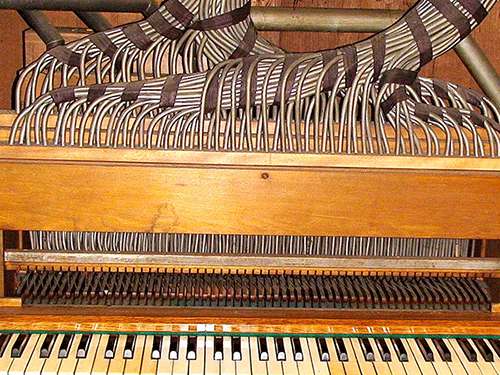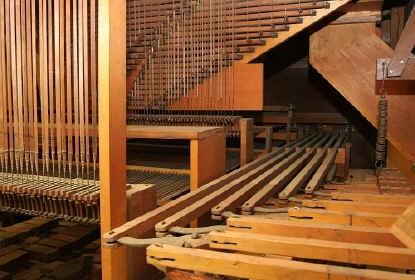As a teenager, Andrew sang in his local choir -St Paul’s, Newcastle under Lyme – and it was in this context that he was first introduced to the workings of the organ by the organist, who was also an enthusiastic amateur organ builder. This sparked an instant and lifelong love for both the sound of the organ and for its internal workings. He worked on the organ with the organist to make some spectacular tonal enhancements to it. The organ was built by William Hill in 1913 as a substantial three manual instrument with pneumatic action. Its specification was typical of those of the time and, whilst excellent for accompanying the choir, was limited in musical variety. The choir organ was ‘spiced up’ in 1963 by Hill, Norman and Beard with a revised specification reflecting the vogue of the day.
By the time Andrew became involved with the choir, the organist, John Norris, had obtained and installed, with the help of an enthusiastic team of friends, a large scale stopped 32′ bottom octave to run the Open Wood down. John had many other ideas and, over the course of the next few years, they added a number of extra stops to the organ. To do this, a simple but effective switching mechanism was added to the pneumatic action involving magnets attached to the pallet motors and reed switched position and adjusted so that the electrically operated system was synchronised with the original one.
Since then, the organ has been rebuilt by Sixsmiths and is a major asset to the town’s musical heritage.
Andrew was involved in work on other organs in the area, including the organ transferred to St John the Baptist, Trent Vale, which was a refurbished tracker action instrument, St Laurence, Chapel Chorlton and St Giles, Newcastle.
On moving to Birmingham to study at the University, Andrew met the organ scholar, Keven Holmes at St George’s church in Edgbaston, and in him found a kindrid spirit. With the encouragement of David Bruce-Payne, the choirmaster and organist, they looked after the rather unreliable Brindley and Foster organ and made some tonal amendments to that organ including acquiring and installing part of the bottom octave (F to A) of the redundant 32′ open wood stop from Christ Church Cathedral, Oxford (The larger five pipes found their way to Tewkesbury Abbey) along with two slightly extended pipes from a redundant large scale 16′ open wood to extend the existing open wood down. A spare record player and a set of sanctuary bells placed on top of the swell box became the zimbelstern! It is sad to se that the unreliability of the mechanism has now meant that the organ is silent.
He was involved in tuning a number of other organs in the area and, whilst doing this, caught the eye of Sixsmith organ builders of Mossley, who offered him employment; the untimely demise of Rushworth and Dreaper precluded him from taking up this employment as Sixsmiths’s employment of some of their staff meant that they were not able to follow through on their offer.
As well as being a fine organist, Kevin was also a bellringer at his home town of Newbury. He introduced Andrew to ringing, teaching him to handle a bell at the remote ring of three at Echinswell. He was introduced to the tower captain at St Nicolas in Newbury, Howard Eggleston, who ignited the interest in bells and bellringing that was to become a major part of his life thereafter.


